My wife is from Oregon, where blueberries can really grow. On our visits up there I see how fast and large blueberry bushes can grow and how productive they can be. While my blueberry bushes here in Southern California are inferior to those in the Pacific Northwest, they do provide my three children with all of the blueberries they can eat.
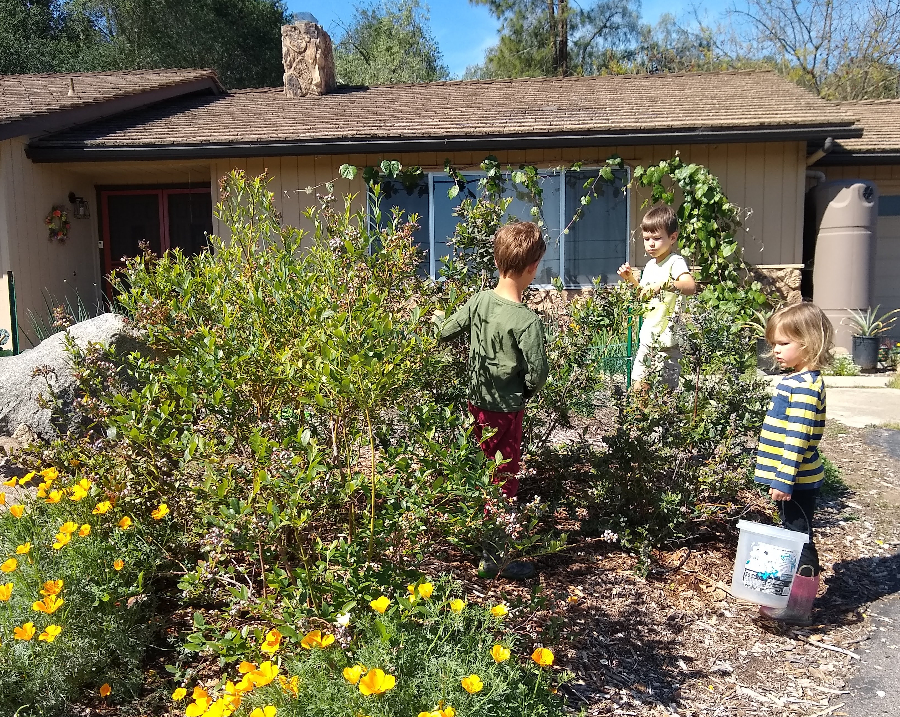
They also grow and produce better today than when I first started growing them more than a decade ago.
This post is about how I’ve found success growing blueberries, as well as how I’ve seen others grow them well in Southern California.
Soil pH
As you’ll read any time you read anything about blueberries, they need soil with a low pH, around 5 according to this University of California publication. We don’t have such soil in Southern California. In the two different gardens I’ve tested my unadulterated soil, they have registered about 7.
So most of us are left with two options: alter the pH of the soil near our blueberry plants, or grow blueberry plants in pots using a mix with low pH.
In a pot
Growing blueberries in a pot is simpler than growing in the ground. All you do is plant a blueberry in a pot that is filled with a purchased mix that is in the acid pH range. Many companies make these mixes for growing azaleas and camellias, for example. Here is one called “Azalea, Camellia, and Acid” from E.B. Stone that you can probably find at your local nursery.
I have seen a number of mature, fruitful blueberry plants growing in mixes like this. I also know someone with excellent blueberry plants who makes her own blend of peat moss, bark chips, and an azalea mix.
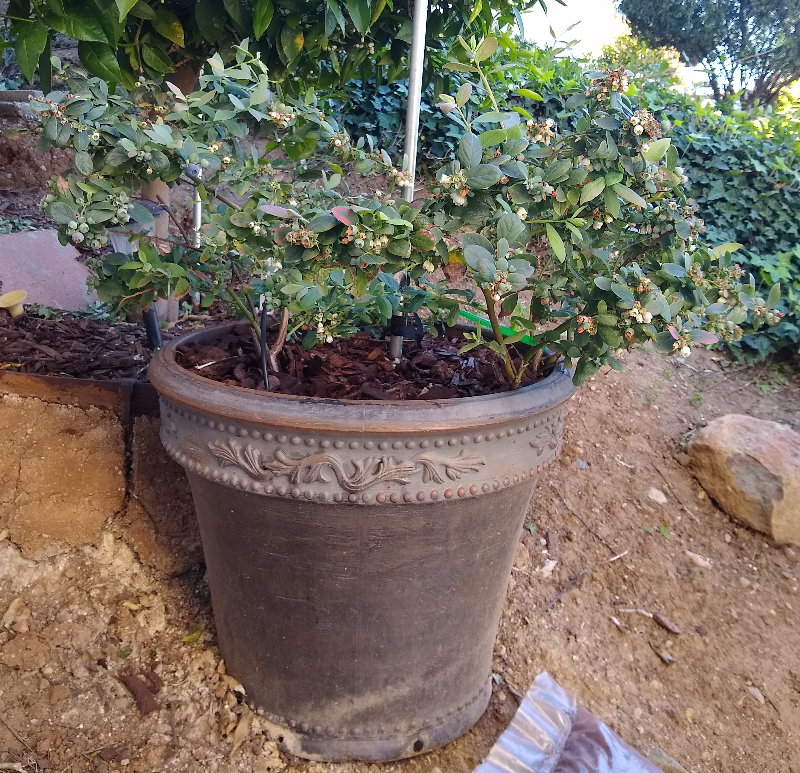
In the ground
On the other hand, I have always grown my blueberries in the ground. Some say this isn’t possible. I’ve heard many people say blueberries won’t do well long-term in Southern California in the ground. But I know that there are commercial growers doing it, and I have seen a number of blueberry plants in the ground in yards doing well after 15 years or more. My oldest plants have been in the ground for about 12 years.
There is no doubt, however, that growing blueberries in the ground in Southern California requires more effort in terms of getting the soil right.
I currently have eight blueberry plants, and I’ve taken different approaches to modifying the soil for each of them. I have a sense of what works and what doesn’t.
First, what doesn’t work is hoping that acidic mulches will be sufficient. I continuously added acidic items to the soil surface around some plants such as oak leaves, pine needles, coffee grounds, and lots of extra rainwater (which has a lower pH than the imported tap water of Southern California — about 5.6 compared to about 8.4 for my particular water district). Yet my plants still began to show chlorosis (leaves with yellowing between the veins), a sign that the pH of the soil is too high for the plants’ roots to take in iron.
I also tried merely mixing a lot of peat moss into the planting hole of some plants, as peat moss is acidic. Those plants eventually turned chlorotic too.
Now for what does work. I have found two ways to successfully green up my chlorotic blueberry plants. One is by adding aluminum sulfate.
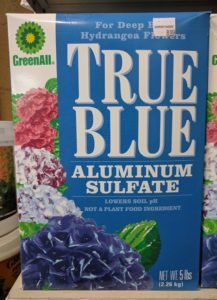
After adding some of that, my plants greened up very quickly. However, I was uncomfortable adding that to my soil so I only did it one time on a few plants — this was back in 2016 — and then I disposed of the product.
For another set of plants I added sulfur pellets.

The sulfur took longer to green up the chlorotic plants, but it was effective and it then became my chosen method. Every year, I continue to add a little bit of sulfur around my blueberry plants and I haven’t seen any chlorosis on them since I started. I also have a gardener friend who grows excellent blueberries in the ground, and she has only used sulfur pellets to reduce and maintain a low pH in her soil.
In addition to the sulfur, I continue to add compost (homemade), wood chips for mulch, and coffee grounds. It is said that if soil is high in organic matter, then blueberry plants will tolerate a pH somewhat higher than the “required” level of 5.5. (See this presentation by University of California farm advisor Mark Gaskell on soil pH management for growing blueberries in the ground.)
Full sun or partial shade
Because blueberries don’t grow wild in hot and sunny places like Southern California, some people assume the plants will appreciate some shade. I tested this out in my yard once.
I bought a few young plants and put some in full sun and some in afternoon shade at the eastern canopy edge of a large orange tree. After a couple years I saw that although the foliage of the plants in the afternoon shade looked better, they produced fewer berries.
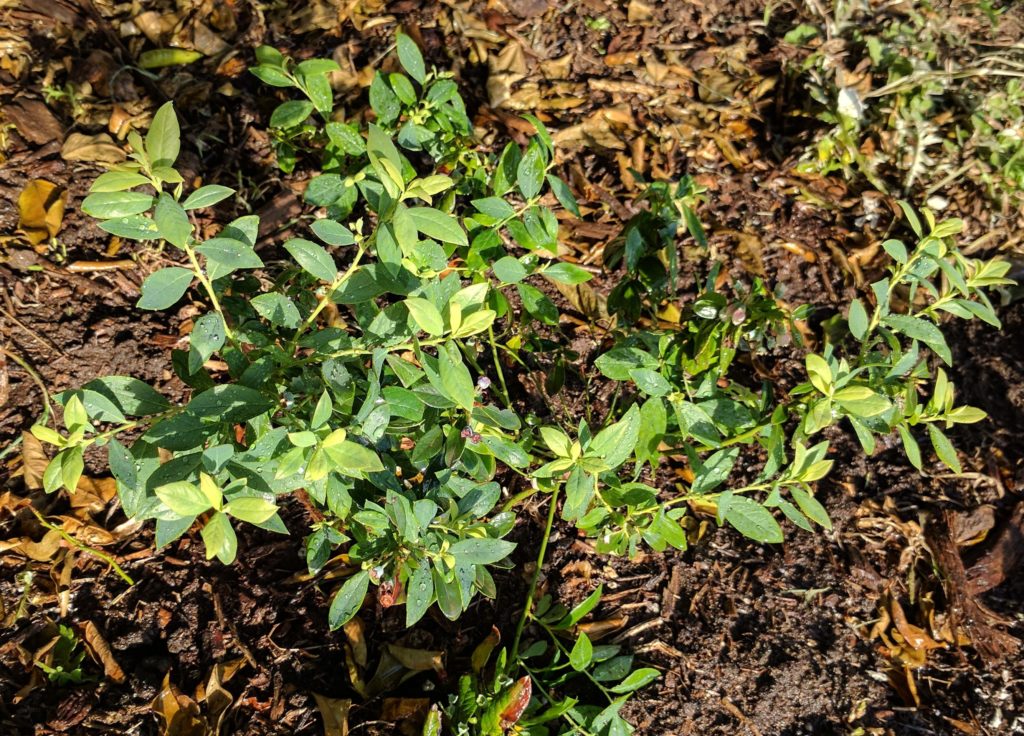
I should note that my yard is located about twenty miles from the ocean and at about 1,500 feet elevation in Ramona, San Diego County. The summer sun is intense here.

Nevertheless, planting my blueberries in full sun has given the most berries. All I have to do is water enough.
Watering
I have watered my blueberries with a watering can, micro-sprayers, and drip irrigation with fine results.
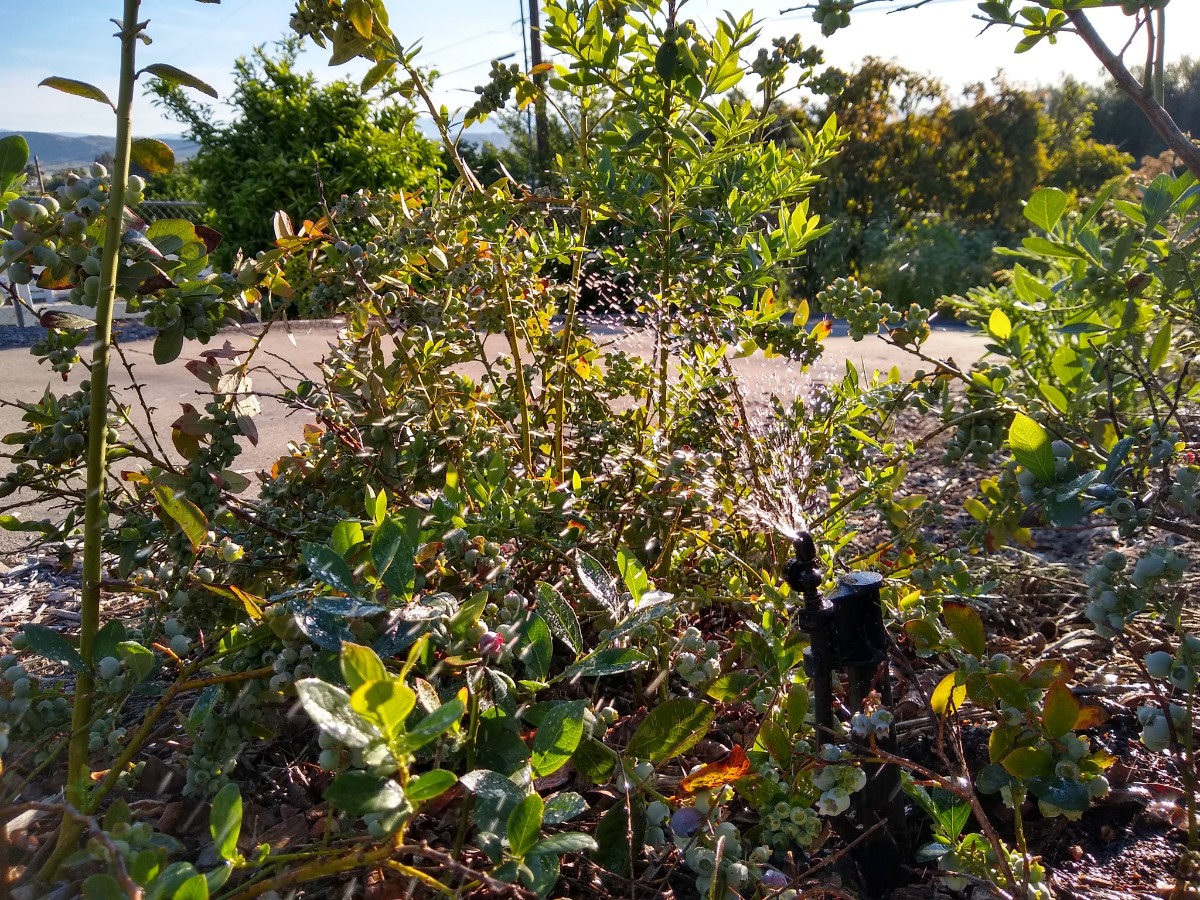
I switched to micro-sprayers for a few years and the plants seemed to like the broader water distribution more than when they were on drip, but I recently returned to drip in order to conserve water and because the micro-sprayers were clogging and spraying inconsistently whenever there was a slight pressure change in the water line.
Whatever watering method, the main thing is to water sufficiently. I have my blueberries on the same station as my vegetables. If the vegetables are getting enough water, then the blueberries are too.
Varieties
I grow a handful of varieties: Misty, O’Neal, Jewel, Jubilee, Emerald, Pink Lemonade, and Sunshine Blue. All of them make very similar blue berries except for Pink Lemonade, whose berries are pink.
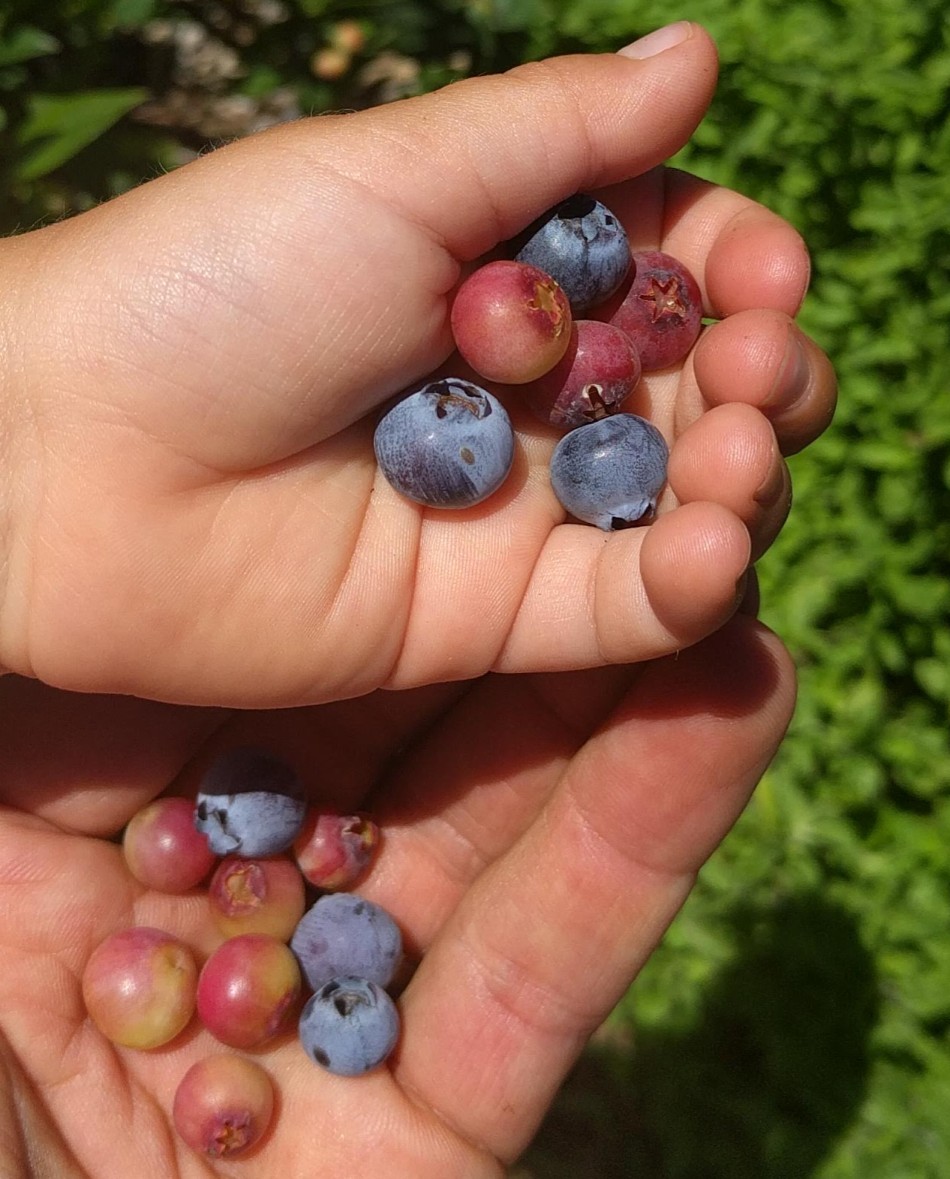
The Pink Lemonade plant is different from the others too. It is the most vigorous grower, and it is the latest variety. After the harvest of all of the blue varieties is finished, we continue eating Pink Lemonade into August.
The earliest variety is Sunshine Blue. This variety also has been the most tolerant of my mistreatment and experiments with it in general. It has always had the least chlorosis and grown better than the others before I got the soil right.
We start eating some Sunshine Blue blueberries in March and then the other varieties come in until a peak in harvest happens around May, waning from there into summer until the last Pink Lemonades are picked around August.
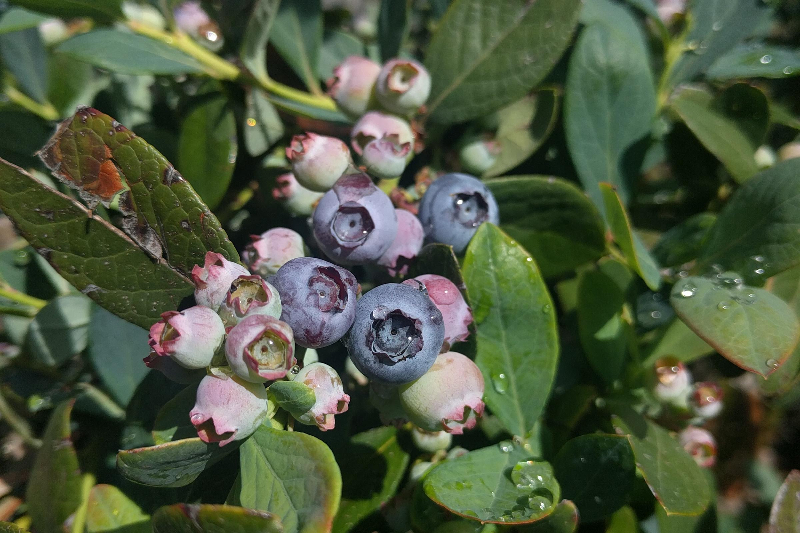
With eight bushes you might think that we’re swimming in blueberries, but no. We have three kids who feast on them constantly, and it’s rare to see many blue, ripe berries on the bushes, and my wife and I still don’t get to eat as many as we’d like. We probably need more like ten bushes, which would be two per person.
Protecting blueberries from birds
This takes into account a bit of loss from birds. At my place, it’s the mockingbirds and scrub jays who help themselves to our blueberries. Some years I just share; other years I get possessive and place a simple net of tulle fabric over the bushes held down by some rocks.
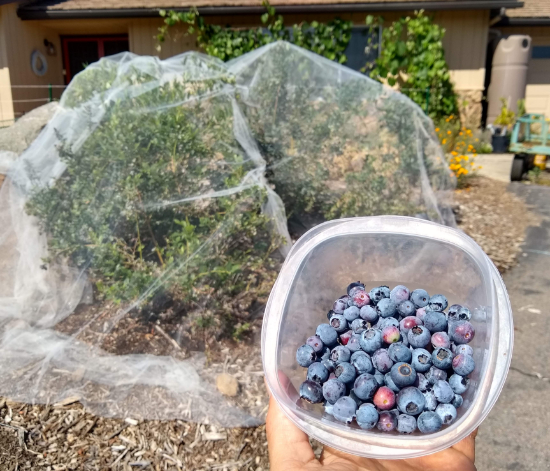
This is “Economy Colored Polyester Tulle” from Paper Mart, a company based in Orange, California.
Here’s a video showing some of my blueberry plants and summarizing how I take care of them:
All of my Yard Posts are listed HERE

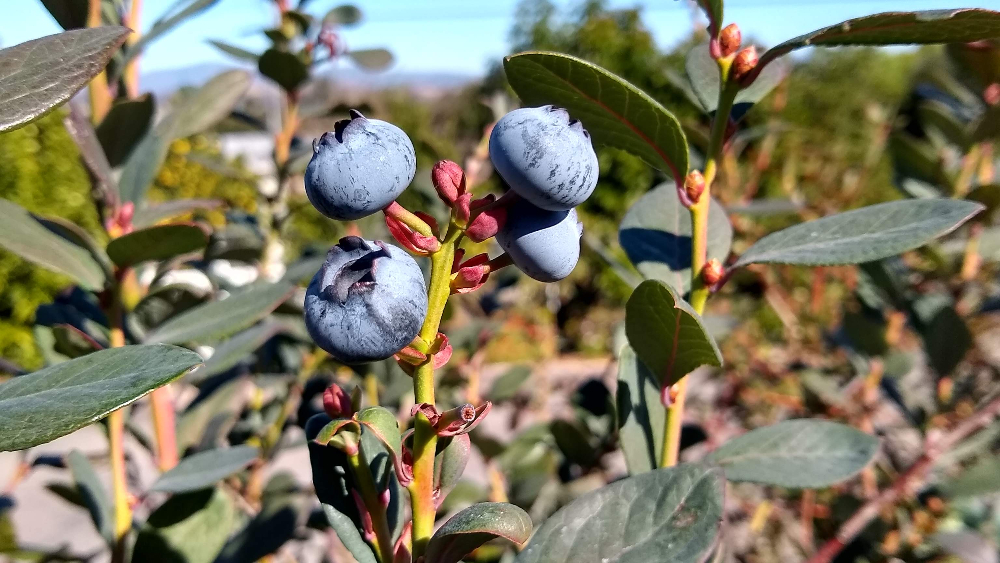


Thanks for the post!
I need to know if I should proceed to pot up my newly purchased CA blueberry that is already (Jan) putting out bloom or leave in commercial container fir spring.
Hi Karen,
My blueberries are blooming right now also. I would go ahead and pot up your plant now; no need to wait until spring.
Thanks for the information. I had no idea. I have been growing blueberries i pots for the past 4 years with little success.
You’re very welcome, John. I wish you the best of blueberry luck!
Hi Greg,
I’m planning to start a small blueberry patch using the majority of plastic 55 gal drums. I’m planning a hugle culture for the bottom 1/3. I have the ability to get the right ph from the start. My questions are: what are the varieties I should consider for the longest season. If Sunshine Blue and Pink Lemonade are the bookends, what varieties are fruiting when? I’m in Riverside. Hot, full sun area. Drip. How many plants would you recommend per barrel? I’m looking for high production and easy to work and protect from local wildlife.
How did this go? I’m local to you and interested in planting some blueberries. Any info you can share based on your experience is appreciated.
When can I prune blueberries in pot. I’m in Orange County ca
I am also in Orange County and curious abut pruning. Mine are growing well in the ground.
Hey Greg, would you say fruiting season for sunshine blue is march-april? I’m looking for a variety who’s production time is before may or after August. Thanks!
Thank you for the tips! I am growing 6 blueberry bushes in Lancaster, CA. We are hotter and drier than your locales. But glad to put your tips into practice. I had my potted plants in full shade. I think I will move them into the sun with good watering and proper soil. 🙂
Good idea to try out some more sun. No doubt, Lancaster is hotter than here, but you might be surprised by how much heat blueberries can handle — if given sufficient water and good soil. The highest they’ve gone through at my place was a record day of 109 one summer. It was after we’d harvested all of their berries, and the only damage was a few burnt leaves.
Hello
Can I plant bushes in plastic barrels?
Thanks
Hi Nancy,
Sure. You might just want to try to shade the sides of the plastic container so it doesn’t heat up too much for the roots near the plastic there.
Hi! We live on the border of Oceanside and vista. Finally found 2 blueberry bushes at a small local garden (a pink lemonade and I forget the other one). Can’t find any anywhere else since covid. Where/when would you recommend looking for them here in SD county?
Hi Rachel,
The best time to look for new blueberry plants is in winter, usually starting around Christmas, when nurseries receive bare root fruit trees.
By the way, I’m starting to enjoy my Pink Lemonade plant more these days since it has a late harvest and since I’m getting better at knowing how the berries look when they’re ready to harvest, which took me years to figure out! They get deep pink and should fall off in your fingers with only a slight twist of the berry. I hope you enjoy them too.
Thanks for the picking tip!!!
Rachel, How are your blueberries doing? We live in the same area and thinking about planting a few bushes. Greg: Thanks very much for a very helpful article!!
Paula, thanks for asking. Let’s just say, I got over ambitious when we first moved onto our land and I planted more than I had time to properly care for—buying fruit trees and bushes is addicting! But life and work and kids and their activities are distracting, ha! Sooooo…my original blueberries were causalities to my faulty drip system and my neglect. Since then, I have bought several more plants at Home Depot and Clausen and Ganter, and this year I have attempted to revive and nurture them, but the results remain to be seen. I’m glad you called attention to this post—I need to get some of those sulfur pellets. So far I’ve been hoping for results from all this rain water, pine mulch, chicken manure/compost, and an organic blueberry fertilizer I picked up at Home Depot. They are alive with a sparse leaves (full sun) and a few fruit for now. Oh, also, I planted the new ones in recycled half wine barrels I got off marketplace.
Hi Rebecca,
We live in the Agua Dulce area. How are your berries doing? We are thinking in getting a few bushes. I hear the do better if you have 2 varieties of berries.
Rosana, My blueberries are doing very well. I have over a dozen bushes now and propbably 5-7 varieties. Some produced better than others. The worst producers for me have been the lemonade kind. In the summer of 2022 my bushes suffered a lot of sunburn. So this year I grew cucumbers and squash over a cattle panel over the blueberry beds. That seemed to be perfect. As soon as the blueberries were done with their fruiting season the other plants grew up the panels and gave them shade during the worst heat of summer. And now those plants are finishing up and giving a bit more sun again to my berries. One thing of note is that my bushes have not grown very big/tall. They remain about 3 feet tall even after some years now. I will focus on better fertilizing maybe. Good luck in the garden! Glad to have you join AV Backyard Gardeners on Facebook to connect with local gardeners.
I love to hear personal stories. Yours is very helpful and is rooted in your own experience. Thank you, Greg!
Thank you, Yajie.
I also love to hear personal stories, which is why I include them here. I like to know why people do what they do and how they come to know things, so I try to never give advice without putting it in the context of my experience.
Thank you so much. I am hoping to add a pink lemonade to my garden but not sure where to purchase one in my area. All online nurseries say it’s not compatible in my zip code 90604.
Hi Ynette,
I think Pink Lemonade blueberry will do fine in your area. I have grown it successfully both near the beach in San Diego and where I am now in the foothills in Ramona.
I placed my blueberry in a self watering container and they did well last year. Now they are flowering. Can I fertilize now
Hi Susan,
Yes, you can fertilize here in February regardless of whether you’re using a chemical or organic fertilizer. Growth has started particularly early on our plants this year. We’re already eating the first berries from our Sunshine Blue.
I’m curious to know what you’re watering with? Municipal city water on a drip or hand watering with altered ph water?
Hi Stephen,
All summer it’s straight municipal water. I used to use drip emitters but switched to micro-sprayers in order to wet a larger area. The plants had seemed to stress a little during heatwaves so I thought that a larger wetted soil volume would help. I think it has, but it’s hard to say for sure.
Since our municipal water has a pH in the 8 range, I make sure to give the blueberries only rainwater all winter into spring. Luckily, I have a tank just 15 feet from the plants.
Greg, Do you have a post about how to store and use rainwater with a method that is not too cumbersome? Thanks!!
FYI,
I just bought some aluminum sulfate for my 2 baby blueberry plants that I have temporarily in 3-gallon containers.
I added elemental sulfur granules to the soil containers but it usually takes 3 to 6 months for the bacteria to work on sulfur to acidify the soil within an acceptable PH range.
My Blueberry plants were suffering from yellowing leaves and poor growth because the PH was at 7.5 to 8.0
I tried watering them with water that I had adjusted to a PH of 3.0 using tap water and sulfuric acid I bought from Walmart, but it didn’t seem to do much.
I then mixed a gallon of tap water (ph 8.0) with 2 Tbls of aluminum sulfate crystals (the exact same brand that you have) and that brought the PH down by 1 PH point immediately.
Seeing the results, I mixed another gallon of water, this time using the 3.0 PH pre-mixed water and added another 2 Tbls of Aluminum sulfate crystals and VIOLA!
My soil PH was at a 4.5!!!
I expect that the PH will drift up again, but this time I’m expecting it to stay in the appropriate range of 4.5 to 5.5.
The planter mix that I’m using is potting soil amended with 50% peat moss, so I won’t need to water too often until the heat of summer hit (its the beginning of Spring now).
The sulfuric acid that I bought from Walmart is actually marketed as a drain cleaner. But its sulfuric acid either way. I used 1/4 tsp and that stuff made 6 gallons of 3.0 PH water. It’s STRONG so if anyone uses it, you’ll need very little!
Very interesting. I am curious as to how quickly pH will rise and how the foliage of your plants will look later this spring. Please keep us updated.
Commercial growers use sulfuric acid (a lot of it) and urea. There’s quite a bit of information about this on the internet if you look for commercial blueberry growing information, such as http://crusty.integritynet.com/ph_meters/Uses_of_sulfuric_acid_as_water_admendment.pdf I tried doing this with plants in the ground and it worked well as long as I used it every month or more. I am planning some new plantings in raised beds that will start with amended, acidic soil and hopefully it will be less labor and chemically intensive to maintain.
Thanks, Jane. As far as I’ve read and seen, commercial farmers of blueberries in Southern California mostly fertilize and manipulate soil/water pH by injecting liquid products into their drip irrigation lines. It certainly works for them, as the proof is in the pudding.
I’ve been monitoring the PH over the last few days and within a few hours, the PH was shooting back up.
I drenched the potting soil with another round of 3.0 PH water with 2 Tbls of aluminum sulfate.
The first day it got back to 6.8 so I treated it with one gallon of 3.0 aluminum sulfate/sulfuric acid-water mixture. It immediately dropped to 4.0. After a few hours, it rose again to 6.5 PH so I treated it with another gallon of aluminum sulfate/sulfuric acid-water mixture.
But this time I added twice as much sulfuric acid to the gallon mixture and it brought the mixture down to PH 2.0
I checked the soil this morning and some areas were sitting at 5.5 and others at 6.0.
I’ve found that Repeated drenching is necessary to stabilize the PH into the normal range that you want.
So far, I’ve used about 5 1/2 Tbls of Aluminum sulfate in the two blueberry pots. At some point, aluminum sulfate becomes toxic to blueberry plants.
I haven’t found any literature that tells me where the limit is with aluminum sulfate and potted blueberry plants.
So I’m going to stop using the aluminum sulfate and play it safe until I find out what the maximum recommended amounts are.
I’ll continue treating with the sulfuric acid water mix between 2.0 PH and 3.0 PH.
At this point, I favor using the 3.0 PH water mixing because it seems less likely to cause any burn damage to the roots.
However, even with drainage, the potting soil has been fairly wet for the past few days because of the 50% peat moss content and it’s concerning me that the wet soil could start to damage the plants as well.
I’m going to treat today to try and get it to stabilize at 4.5 for the next few days. If it does stabilize at 4.5PH, I won’t have to water or fertilize for at least a week and 1/2 and I can give the root system a needed break and time to acclimate to its new PH soil environment.
I have a feeling that microbes in the soil and their alkaline byproducts are responsible for raising the PH within hours of treating it with the acidic water treatment.
We’ll see how long this takes to stabilize the PH.
Maybe the pro-alkaline microbes need to die off and be replaced by pro-acidic microbes before the soil can stabilize, this is just a guess, but we’ll see what happens.
I just checked the PH of both BB plants and it was around 6.0 so I Added the 2.0 PH water mixture and the plants are now sitting in 5.0 PH potting soil.
The potting soil immediately raises the PH of the liquid drench. There’s been no decline in the plants since I started amending the PH over the last few days so hopefully, the plants are taking damage and are good to go. The sams club across the street from me has them for $5 ea. So I’m not too worried if I can’t save these two.
Hopefully, this works out though.
I’ve also pulled them out of direct sunlight for the time being so that they don’t take heat stress while trying to recuperate.
Do you prune blueberry bushes when they are leggy? Should they be like shrubby bushes?
Hi Laura,
I don’t, personally. I let their ends grow however they please. The plants of blueberry farms I’ve seen up in Oregon are not like shrubby bushes. It doesn’t look like they cut back leggy branches either.
The only things I ever prune on my blueberries are dead branches, which I cut out. Otherwise, I don’t bother with the advice of others who say to remove twiggy branches or crossing branches in order to increase sunlight to the interior. I’m not sure that what I’m doing is the best way, but since my bushes seem to have plenty of berries throughout I’ve yet to spend any extra time pruning them.
I know I am late to the party but…..Thank you Gregg for such a great post. I’m in Southern California and have had really good success with my bountiful blue in a pot. When you say you don’t trim at all does that mean you don’t even trim the little skinny straggling branches? You only trim dead wood? Thank you so much
Hi Kc,
Yes, I only cut out dead branches on my blueberries.
I wouldn’t recommend fertilizing anything that I was planning to eat, with aluminum sulfate, nor would I recommend it to others. It’s great for turning hydrangea flowers blue, though. 🙂 Hi-Yield makes a product called Iron Sulfate. I ran across the product at Ace, then also found it at Walmart ^.^ . Blueberry plants like and need iron, it lowers the soil ph instantly, helps with chlorosis [providing the soil ph is correct], and iron is safe for human consumption. I’ve found that acidifying the water with vinegar or another like acid works so-so, and soil sulfur takes forEVER to work.
I grow in OC, and San Gabriel valley. I only grow my blueberry plants in pots, and prefer a home-made mix of about 2 parts pine bark, 1 part coarse perlite or pumice, and a heaping 1 part peat moss… mix in some cotton seed meal at the onset of growth in the spring, a lighter feeding in autumn, and you’re good to go. Once potted, I like to sprinkle some iron sulfate on top, water it in, then test the soil to make sure it’s where I want it. I tend to check my soil ph whenever I water, to make sure it stays right where I want it. Why I make my own soil – all of the pre-made,”acid loving soils” I’ve ever tried, never seem to be acidic at all, testing out at 7.0, and they tend to be more dense than I’d like.
Gardening is much more fun when you get your hands dirty ^.^
How much …how often …do you apply coffee grounds for container pot (black nursery variety)…9 month old plant….thank you
Hi Phyllis,
I have no idea what the limits are as to how often and how much coffee grounds one can apply to blueberries. I’m not aware of anyone studying this formally.
I bet you can’t apply too much to your plant in the container pot though. The coffee grounds will overflow the side quickly.
I keep putting all of our coffee grounds under my blueberry plants, and I’ve been doing so for nearly ten years on a couple plants, and they’ve yet to complain.
Where do you buy your tree in San Diego
Have you ever tried to propagate a blueberry? I’m thinking about trying it.
Has anyone heard of applying Magnesium Sulfate (epson salts) to blueberry plants and is this a more natural route to lower soil PH?
Hi Danielle,
I’ve never heard of anyone trying to lower soil pH by using magnesium sulfate. I don’t know if it would have that effect; I’ve read that it doesn’t.
Hi Walter,
I haven’t, but I’ve been thinking about it too because I’ve got a couple blueberry bushes that have branches sprouting up six or so inches from the crown of the mother plant, and I’ve read that you can dig such suckers up and transplant them. If I try it, I’ll note how it turns out. Let me know what you try too.
Thanks. I’ll let you know!
Hi, we are in Pacific Beach and plan to plant our blueberry bushes in a pot/container. Any preferences on what type of pot is best? We have heard about the 1/2 wine barrels. Today someone recommended using terracotta pots.
Hi Lynne,
My preference would be for half wine barrels over terracotta pots. Many people have grown great blueberry bushes in half wine barrels, so it’s proven. And the plants (not blueberries) I’ve grown in terracotta pots have never done as well as those I’ve grown in wood or plastic containers. I don’t know if it’s the porosity of the terracotta or something that is leached from it. All I know is that the plants in them (tomatoes, avocados, etc.) never did great so I no longer use them.
Just chiming in: I just watched a video from the blueberry expert at Epic Gardening and she said the reason she ditched terracotta pots for growing blueberries was the soil dried out far too quickly. She now uses “fabric” grow bags with great success. (Note that Epic Gardening earns a commission on the the grow bags they sell, so…). In any case, that’s one blueberry lover’s experience.
I have grown blueberries from cuttings. I’m in North Orange County. Scions must stay moist, not soaking. I strip leaves except for 1-2 at the very top end. Covering the scion in parafilm helps. It’s like magic! I parafilm the top 4” of a 6” cutting; then the lower 2” bare in the ground. You can use rooting hormone and you can make a 1/2” vertical cut at the bottom of the scion to encourage rooting (just scraping the brown bark and opening up The cambium/ light green area, before the center wood, will produce roots. The soil I use, is mostly peat moss with some perlite, a little healthy yard soil, and some dry leaves. And, last of all, you get the most success when the plant isn’t in active growth nor fruit production (usually Jan/Feb). Be well! Love your posts!
Hi Kat,
I love this! Thank you so much for sharing, especially the tip on using parafilm. I’m putting it on my calendar to root some cuttings of my best blueberries next winter.
Greg! Thanks for your info on blueberries. I learned blueberries have a mycorizzal buddy that helps them grow. Next time I try I will take a scoop of soil from under a friend’s abundant blueberry here in the SF bay area. That is probably also why they need to have consistently moist soil.
choose love!
I have a narrow, very sunny plot that I’d love to plant blueberries. I found a dwarf variety, Tophat Dwarf – it grows about 18″ tall. Perfect for my needs but will it grow well here? We live by the beach in Malibu, CA. Many thanks for your wonderfully enlightening posts!
Hi Mia,
I don’t know anything about Top Hat blueberry firsthand, but it doesn’t sound like a great choice for Malibu based on the chill hours (1,000) listed on the Monrovia site: https://www.monrovia.com/plant-catalog/plants/1307/top-hat-blueberry/
In Malibu by the beach, there are probably years when you don’t even get 100 chill hours (maybe a bit more if you’re at the mouth of the canyon).
But! You can prune other varieties of blueberries to keep them down to only a couple feet tall if you want. Blueberries take to pruning very well. Just give them a haircut each year in the early part of summer right after you’re done harvesting.
HI there, Greg. Thanks so much for your super helpful website! I live in Claremont, CA and have been having a lot of trouble with my blueberries getting burned. This summer I even put shade cloth over them when the temps spiked up into the hundreds but the foliage still looks very damaged. I have three different varieties planted in half-barrels and they’re in a spot where they get sun for about 2/3rds of the day (not late afternoon). All of the varieties have produced well in the past. The 2 bushes that got burned last summer didn’t produce any fruit this year, alas. Do you have any advice for either helping to prevent this or maybe helping them recover if they do get damaged? Or maybe I should just give up, given that it looks like our climate is changing in such a way that these super hot days will become more frequent?!
Hi Lauren,
Bummer about the blueberries. I feel like I don’t yet have a complete grasp on why some blueberries get burned and others don’t, but I can say for sure that it’s not due strictly to temperatures rising above a certain threshold. It was 114 and 115 degrees on Labor Day weekend in my yard, yet my blueberries look nearly untouched. On the other hand, in past years I’ve had them get lots of damage in lesser heat waves. I’ve seen similar discrepancies in other yards.
My best guesses as to what helps blueberries get through heat are: lots of mulch covering their roots (their roots are shallow); age (older plants seem tougher); lavish watering a day or two before the heat arrives; broader watering than drip (mini sprayers have worked well on my plants for the last few years, since I switched from drip); appropriate soil conditions (low pH and lots of organic matter).
It might also help during heat to have plants in the ground as opposed to in containers. The soil in the ground is cooler, and the soil in the ground retains moisture longer than most mixes put into containers. I know this is irrelevant to you at this point, but what I would try is adding something around the container to shade its walls, especially on the south side. I do this to most of my container plants in the summer, and I use those reed fences that you can buy for privacy screens.
As for helping the damaged plants at this time, I wouldn’t do anything except prune out the dead branches or branch tips.
Hi, Greg. Thank you for all the great info! I have relied on your avocado ripening chart for years (it has saved me from a lot of trial and error)–now you have inspired me to grow blueberries–in half barrels because my soil is less than ideal here in San Juan Capistrano. I drilled holes, put a nice layer of lava rock and small bits of lump charcoal (from the bottom of the bag) and filled with with 1:3 compost:acid mix, with a handful of amendments (volcanic dust and acid food). Irrigating with mostly pond water (rain water when available). One pot each of Sunshine Blue, Bountiful Blue and Southmoon in partial sun (at least for now). Let’s see what happens.
Hi Jeff,
Yes! Tell me how it goes. You might be inundated with blueberries in a couple years. They are so worth it. Everyone in Southern California should have a few blueberry bushes in barrels by their front door.
Hello. Just found this blog as I am searching for help with my blueberry Bush. My son bought me a jubilee bush last summer and soil that the nursery said was appropriate. A few months later it lost all of its leaves and after reading that I should have added peat and sulfur I thought it was dead. However, now it is flowering. I’ve read that I should nip the buds but should I also amend the soil? Do you think it might grow leaves again? Any advice for this novice gardener would be appreciated.
Forgot to add that I am in San Diego, neighborhood of mission hills.
Hi Rahel,
Some of my blueberries are leafless right now too. Each variety is a bit different in this respect. Most of my blueberries are blooming heavily right now too. They will all grow leaves later. The flowers grow first.
I wouldn’t nip the buds at the branch tips because that is where the flowering and new growth occurs.
Yes, you can add sulfur now if you want, which will slowly break down and affect the pH of the soil and help the blueberry bush be happier.
Awesome write up. I having been growing blueberries pretty successfully out in East County San Diego (Lakeside).
I always look forward to your emails.
I always look forward to comment like this. Thanks, Eva!
Hi Greg! Great timing with your blueberry update. This morning I listened to Garden Basics podcast with Farmer Fred, Water Trough Gardening. He grows his blueberries in water troughs, primered, painted, and raised on four-inch blocks. I planted mine in 1/2 wine barrels, they are doing great and crazy delicious, but the barrels are falling apart after three years, so I’m now holding them together with duct tape until they are ready to be repotted. I have several of each of these varieties – Emerald, Misty, Sharpblue, Southmoon and Sunshine Blue – and I want more! I’m curious, what are your thoughts on water trough container gardening in North County San Diego (Vista)? Thank you for your postings, I go back to them over and over again!
Hi Nancy,
I’ve yet to grow anything in a metal trough myself, but I’ve seen people growing things well in them. I don’t imagine you’d have a problem in Vista.
I do find it beneficial to shade the walls of any container, especially on the south and west sides, during summer though. Otherwise, it gets too hot there and roots can’t survive. I just wrap containers with reed fencing. Painting a light color would help just the same.
I have seen people growing blueberries very well in ceramic pots in hot locations too, by the way.
Thanks, Greg, for getting me to rethink my options. Reed fencing is a great idea…much better than shading with cardboard boxes. Whatever it takes, right?
Thank You Greg for this week’s Blue Berry article. I’ve a great deal of “Soil Mending” to take on when I return home. Off the subject of how to improve blueberry production, your article brought back the following memory: Decades ago, while in college, I was offered and accepted a summer day-laborer’s job in Alaska. As soon as school let out I drove, from So Cal, north via the AlCan Highway and arrived in Fairbanks just as the days were turning into night-less wonders. My first job was near the community of Healy, on the north side of Mt. McKinley. One late afternoon as we were heading back to our rental units my boss, Jim, made the comment that we were passing a multi-acre field of wild blueberries. Growing up in Goleta, I’d never seen wild blueberries nor even tasted them, so I asked him to stop so that I could pick and taste a few. He stopped, explained how to tickle-pick the berries and down the sixty foot embankment of reused gold mining tailing rocks I went. The plants were growing no higher than my knees and looked more like short low growing juniper branches spread out at ground level. Jim had explained, “Lift the branches from their respective ends and then simply draw your fingers under the berries as you lightly tickle them and the ripe ones will drop into your hand.” My-oh-My Greg did they ever. They were dark blue, the size of rabbit dropping, super sweet and consumable by the handful.
UNTIL!!!
Until, some minutes later when Jim and my other crew members who had stayed in the truck started screaming at me to stop and get back in the truck…ASAP!!!! Surprised by the urgency in their voices, I looked up at them to ask why(?), but instead followed their pointing fingers which were directing me to the far off diagonal corner of the berry patch. Following their distant focus, I spied what looked to be gigantic ten-foot tall brown bear standing on his/her hind legs and sporting a blueberry stained midriff. Wow! Minding Jim’s directive [screams] I rapidly climbed to the roadway and jumped into the bed of the truck. Once settled I looked down at the field and there below us was an out of breath snorting bear standing exactly where I’d started my climb. His/her size and demeanor impressed upon all of us that I had trespassed into his/her domain, and, that I/we should never return, and, surprise-surprise, we never did.
At my granddaughter’s insistence, I have told the above story year after year when they arrive for summer time visits and especially when we are picking handfuls of tickle-ready-blueberries from our garden, sans of course any unfriendly blueberry stained Alaskan brown bears.
Awesome, Jock! I love it!
I have all the usual varieties of blueberries and I also bought 4 bushes from Armstrong – price was high, but “Bountiful Blue” have a unique flavor from the rest – excellent flavor. They are worth the money. I’ve been growing from them for about 4 years now.
Greg – thank you so much for the article – I’ve read this article probably twice a year for the past few years as I hope and dream my blueberry patch into existence. Looks like this year will be the one! Since you’ve had a few years, and posted your May 2021 update, would you have any further reflections?
Which varieties are producing the most for you? Which varieties ripen early, mid, and late for you? I’ve got room for 15 bushes, and want to plant for successive ripening.
Also any recommendations on successful care for the bushes as they age? Thanks!
Hi Caleb (or is it really Cable?),
Thanks for this great idea. I’ll find some time in the next week or two to add those ideas to the post. For now, let me say that my latest variety is Pink Lemonade.
Thanks for the post. How much and how often do i add coffee grounds, if that’s what I mostly have for fertilizer for blueberries? Do you think fallen bamboo leaves would be similar to pine needles?
Since you brought up the subject of growing blueberries, I had a question about my blueberry plants. Two of mine “pink lemonade and sunshine blue” had a shoot come up from under the ground. On both of them the shoot is very aggressive and healthy. They do not have any flowers or blueberries on them though. Do blueberries have rootstock? Do the shoots just need a couple years to produce fruit? Thanks again Greg
Hi Walter,
I’ve never heard of anyone propagating blueberries by grafting onto a rootstock. I’ve only heard of blueberries being propagated by rooting cuttings, by using tissue culture, and by using those root suckers you’ve seen. You can cut them out and transplant them.
I get the root suckers coming off my plants too, and they grow fast and strong at first but eventually slow down and bloom. So if you have the space you can let them grow, but if you’re trying to keep your bush restricted to a narrow area then you might want to cut them out.
Thanks for the response. I’ll be glad to keep them.
Planted Misty and Sunshine Blue in large pots of pure peat moss (quite acidic although I added some sulfur pellets). Got excellent growth and bearing in full sun in Irvine. Except for jays eating all the fruit! I tried bird netting which didn’t work (jays are smart) and then gave up. I should have used the kind of protection you recommend. Kids enjoy picking and eating blueberries. Could be something deep in our caveman genes. 🙂
Hi Randy,
Pure peat! Cool! Are you adding any kind of fertilizer or any mulch?
So true about kids naturally loving to pick and eat. My kids are used to being told to go find their own snacks in the yard, but when their friends come over they don’t need to be encouraged to forage. The friends immediately love doing it too.
Though I am a medical doctor I spent most of my time in raising fruit plants in some parts in Nepal. The berries are fascinating to me. Can anybody advise me where can I get those plants if I want to raise them?
Hi Benu,
I got my first blueberry plant from Territorial Seed Company in Oregon, and I’ve bought many other plants from them too. Unfortunately, it looks like they are temporarily not shipping internationally. You might keep an eye on that or contact them to see when they will: https://territorialseed.com/pages/shipping-info
I think there are still arrest warrants out on me for how many blueberry plants I’ve murdered. I’m gonna try your method and see what happens.
Hi Bob,
I’d thought I’d killed some in the past only to have them recover completely once the sulfur had had enough time to bring the pH down (at least that’s what I think happened). So I no longer give up on blueberry plants that look chlorotic and sparsely foliated, as if they’re dying. The sulfur can take a year or more to really work, but eventually it seems to really work — and the blueberries thrive.
If you’re extremely patient and smart, you would incorporate sulfur into the planting area a couple years before planting. I’m neither extremely patient or smart though.
Do you add sulfur several times a year?
I’m really hoping to grow more blueberries since we eat them with breakfast all the time! In Sonoma County we have freezing temps then have gone in recent years to 100+ summers. I’ve got my starter in a pot it is looking ok in its 1st year – but it had fruited then we had a frost this winter and the blossoms shriveled. Without any advice, I just cut them all off thinking for young fruit trees/bushes you’re supposed to drop the first couple years fruit. Any truth to that? I do want to add more southern highbush varieties without breaking the bank if they die. I think for zone 9b Jewel, Sunshine, Misty or Jubilee. Should I focus on early, mid, late so that when they finally produce fruit we’ve got options throughout the season?
I’ve been growing blueberries for that last 3 years in pots and raised beds.
I settled on using one part cactus soil with one part peat moss and an appropriate amount of sulfur pellets thrown in as my planter mix. This works well for me. I have happy blueberry bushes.
However, after watching a youtube from Colorado State University about planting straight into peat moss bales buried in the ground, I might just try that. The video is long but very worth while.
https://youtu.be/4llB13uEjWY
Vista, Ca
usda zone 10a
sunset zone 23
Hi Greg!
I just started growing blueberries and am excited for a delicious harvest. My question is about different varieties. I currently have 3 bushes: star, misty, and sharpblue. I read that you are growing a pink lemonade and I think that variety seems like a tasty option (plus I like the idea of being able to have a harvest later in the season too). However, I live Whittier, CA which is in zone 10a, and after some research, I read that pink lemonade grow in zones 4-9. Do you think I would be able to grow this variety successfully or would I be setting myself up for frustration and failure?
Also, I’m growing all of my bushes in ground after amending the soil with an acid soil blend, peat moss, and a sprinkle of perlite. I also have them in full sun.
Hi David,
I think you’ll do fine with Pink Lemonade there in Whittier. I know someone growing it long term in a climate like yours (Fallbrook), and I grew my plant for a couple years in a climate even slightly milder than yours (near downtown San Diego) before I transplanted it to my current yard.
I want to live where you just go out to country roads and pick berry plants
Hi Greg
One year old blueberries in a 1/2 wine barrel. Other than coffee grounds and sulfur pellets, do you recommend a specific fertilizer during the year? Dave Wilson Nursery recommended -fertilize possibly in April with low nitrogen and double phosphorus and potassium with a humid acid base. Your thoughts?
Hi Jay,
I’m useless when it comes to recommending fertilizer, sorry to say. I don’t use purchased fertilizers so I don’t have any experience to speak from. I’ve only added wood-chip mulch on my blueberries and compost (sometimes containing some chicken manure). But whatever Dave Wilson recommends will probably work.
I’d just say that you shouldn’t get too concerned about the details of specific N-P-K proportions, unless someone provides specific studies that show evidence for such a concern. I’ve found that such specific recommendations often have no concrete foundation. “How do they know?” we should always ask. Show me the evidence.
Hi Greg. I bought a blueberry plant and potted it two years ago here in Irvine. That first year, it produced a generous amount of berries. Throughout the summer of ’21, I neglected to water it and it looked like it was dead. I cut it back to within 2 or 3 inches above the soil and by fall, it had had started to sprout leaves again, and took off. This past February, it was totally covered with blossoms and I thought we were going to have a huge crop of berries. But then the blossoms began to drop off and our harvest this May was down to about a quarter cup of berries. The pot I have the bush in is watered daily by a drip system, and every couple of months I toss in handful the kind of acid that I use to blue my hydrangea. The soil in the pot is ordinary potting soil from Home Depot. Can you tell what you think the problem was and how to correct it. Many thanks, Don Gates
Hi Don,
It’s tough to assess these things remotely, but it might be that the watering was the problem and the bush still needs time to recover before it produces much. I have had a couple blueberry bushes go through similar tough times yet recover fully after a few years — but it did take a few years.
I have read recently that coffee grounds (fresh or used, nobody distinguishes which one) are not good for blueberries. Their reasoning seemed sound. I used coffee in my soil mix a while back and am not happy with the results. I am now looking for Rabbiteye varieties. I have read several articles that recommend them for zones 9 and 10. Rabbiteye varieties are almost impossible to get in California. Do you know of a source in Los Angeles? I have over thirty blueberry plants. I grow very variety that I find. I build PVC cages covered in plastic chicken wire and then covered in shade cloth. Each one costs me around fifty to one hundred dollars in materials depending on the size and ten hours to make. I am a retired aerospace engineer with lots of time on my hands. I thank everyone for their comments.
Hello Dennis I grow 7 different Rabbiteye BB. Email me about where to find Rabbiteye BB.
Dennis Lee,
For BB sources for rabbiteye, northern and southern highbush varieties; I use the Dave Wilson Nursery website then pick them up at my local nursery. If it is something that I want to try but should not (which is how I have come to love Pink Lemonade) I order from Berries Unlimited. Huge variety and ample inventory. Good luck.
Today I started an experiment where I mixed together peat moss and a good potting mix (fifty/fifty) and threw in some pearlite. I then mixed together a fifty/fifty mix of distilled water (PH 7.0) and diet 7UP (PH 2.7). I then completely wetted out all the dirt and potted a young blueberry plant in this mix. My intention is not to use city water at all for the life of this plant. I am hoping that I can maintain a soil PH of 4.5 by using only my special PH mix. Our city water is very hard (lots of minerals) which are not good for the roots. Also using city water alone will constantly raise the PH beyond what Blueberries can tolerate.
Good article and the video complementing it is a nice touch. I notice your Berries are accompanied by California Poppies, which have begun appearing in my Bluberry site here in North Idah also. I take that as a good sign naturaly. Thank you.
Great write up as always Greg. How do you measure the PH of the soil? In the comments, people seem to know their specific PH levels. Thanks!
Can you grow blueberries in a greenhouse in Southern California?
Hi Greg. I’ve read that in San Diego County there is a possible second crop of blueberries around this time of year. Have you experienced this on your bushes? I’m experiencing what seems like what could be a nice fall crop on most of my 10 bushes. If the Santa Anas keep going they might just ripen up enough for Thanksgiving. I’m in the more coastal side of Vista.
Have you experienced this before? Thanks for your thoughts.
Hi David,
I do get small “off” crops from time to time. The best one was in 2020 around Thanksgiving time.
This year, I did have a lot of late berries, through September, but I don’t have a fall crop.
I am seeing a small number of flowers on a couple bushes right now though. I guess those will ripen sometime in late winter.
I don’t know how to explain these phenomena, but I would assume they’re related to the weather. What I do know is that I love being able to go out to my bushes and find at least one blueberry to eat, sometimes hiding deep inside a bush, on most days of the year!
Hi! I lost my blueberry bush last year after about 7-8 years, and the grossbeaks and I are missing them. I was thinking of trying them in a pot this year instead of the soil so I would have better control over the PH, etc. Are most or all blueberries self-pollinating or do they need a mate in order to produce berries? I’ve read yes and no, and my blueberry bush, while not prolific (altho those grossbeaks love them, so who knows, ha), I usually had enough to satisfy the 2 of us humans here. Just wondering if I need to watch my variety and plan on 2 other than 1. Thanks for your info! robin g., mission viejo, ca, orange county, zone 10b